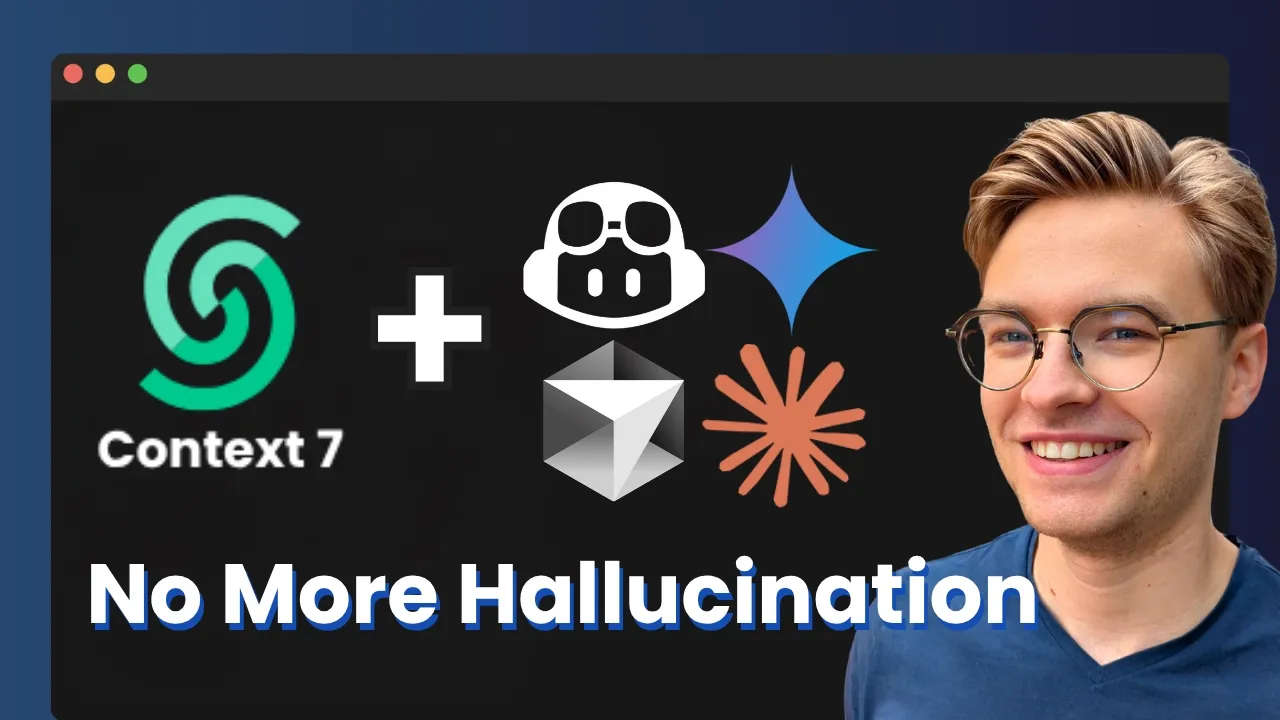Why Does AI Give Outdated Code and How to Fix It?
AI coding assistants are stuck in the past due to training data cutoff dates. They suggest deprecated functions and outdated patterns. Bridge this knowledge gap by augmenting AI with current documentation and recognizing when to verify suggestions.
Quick Answer Summary
- AI models have fixed knowledge cutoff dates
- Frameworks update faster than AI training cycles
- The gap worsens with rapidly evolving technologies
- Verify suggestions against current documentation
- Augment AI with real-time information for best results
Why Does AI Give Outdated Code and How to Fix It?
AI gives outdated code because models have knowledge cutoff dates - everything they know comes from training data available up to that point. Meanwhile, frameworks update weekly. Fix this by verifying AI suggestions against current docs and augmenting prompts with recent documentation.
Every AI model learns from historical data up to a specific date. GPT-4 might know frameworks as they existed months or years ago. Claude has its own cutoff. But software evolves continuously - new versions release, APIs change, functions get deprecated, and patterns shift. To understand how to effectively work with AI coding tools despite these limitations, see my comprehensive AI coding assistants guide for engineers.
This creates dangerous situations. Your AI confidently suggests code that worked six months ago but fails today. It calls functions that no longer exist, uses parameters that changed completely, or follows patterns now considered anti-patterns. The AI doesn’t know it’s wrong - it generates based on patterns from its training data.
The solution involves active verification. Always check AI suggestions against current documentation, especially for newer frameworks. Test code immediately rather than accumulating debt. Recognize which technologies your AI knows well (stable, mature ones) versus poorly (cutting-edge ones).
What Is the AI Knowledge Gap Problem?
The knowledge gap is the growing difference between what AI knows (from training data) and current reality. As technology accelerates, this gap widens daily, causing AI to suggest deprecated functions, outdated patterns, and approaches that no longer work.
Technology evolution accelerates, particularly in AI-related fields. Consider these update frequencies:
- React: Major updates every few months
- AI frameworks: Weekly significant changes
- Model Context Protocol: Bi-weekly specification updates
- Cloud services: Continuous feature rollouts
By the time an AI model trains, tests, and deploys, its knowledge is already months old. Each passing day widens the gap. This isn’t temporary - it’s fundamental to how AI training works.
The gap creates cascading problems. Outdated suggestions lead to broken code, debugging mysteries when “correct” code fails, wasted time implementing deprecated approaches, and missed opportunities to use new capabilities. Developers fight their tools instead of being empowered by them.
How Can I Verify if AI Code Suggestions Are Current?
Check official documentation for the specific version you’re using, test code immediately rather than accumulating suggestions, look for deprecation warnings in your IDE, and be especially careful with rapidly evolving frameworks.
Develop a verification workflow. Before implementing AI suggestions, check the official documentation’s changelog or release notes. Look for “Breaking Changes” sections that list deprecated features. Many projects maintain migration guides highlighting what changed.
Test incrementally rather than accumulating code. Run each significant AI suggestion immediately. This catches outdated patterns quickly before they compound. Modern IDEs help by showing deprecation warnings - pay attention to these signals.
Version awareness matters. Always specify which version you’re using when prompting AI. “Using React 18” produces better suggestions than generic “React” queries. Include version constraints in your questions to get more relevant responses.
High-risk areas need extra caution: frameworks less than 2 years old, anything with “alpha” or “beta” status, rapidly iterating AI/ML tools, and bleeding-edge web technologies. For these, assume AI suggestions need verification.
Which Technologies Have the Biggest AI Knowledge Gaps?
Rapidly evolving technologies like Model Context Protocol (MCP), new AI frameworks, JavaScript frameworks with frequent updates, and bleeding-edge tools have the biggest gaps. Stable, mature technologies have smaller gaps.
Bleeding-edge AI tools top the list. Model Context Protocol updates bi-weekly with specification changes. New frameworks like LangGraph or CrewAI evolve rapidly. AI model APIs add features constantly. Using AI assistance for these requires extreme caution.
Modern JavaScript ecosystem creates challenges. Frameworks like Next.js, Remix, or Astro update frequently. Build tools like Vite or Turbopack change rapidly. Even established tools like React introduce significant changes regularly. AI suggestions often lag by several versions.
Conversely, stable technologies work well with AI. Python core language features remain consistent. Established libraries like NumPy or Pandas have stable APIs. SQL fundamentals don’t change. HTTP protocols stay constant. AI excels at helping with these mature technologies.
Use this knowledge strategically. Rely on AI for stable, established patterns. Verify everything for newer technologies. This targeted approach maximizes AI benefits while avoiding pitfalls.
Should I Stop Using AI Coding Assistants?
No, don’t abandon AI tools - learn to bridge the knowledge gap. AI remains valuable for established technologies and patterns. Augment AI with current documentation, recognize its limitations, and verify suggestions for newer technologies.
AI tools remain incredibly valuable when used appropriately. They excel at established patterns, boilerplate generation, and explaining concepts. The key is understanding their limitations and compensating for them.
Effective strategies include hybrid approaches. Use AI for initial structure and patterns, then verify against current documentation. Let AI handle repetitive tasks while you focus on framework-specific details. Combine AI’s pattern recognition with your current knowledge. For broader strategies on working collaboratively with AI rather than fighting its limitations, explore my guide on working with AI not against it.
Build habits that bridge the gap. Keep documentation open while coding. Create snippets of current patterns AI doesn’t know. Use AI for inspiration but verify implementation details. This balanced approach maintains productivity while avoiding outdated code.
The future points toward AI tools that access real-time documentation. Until then, successful developers combine AI capabilities with active verification and current knowledge.
How Do Experienced Developers Handle AI’s Outdated Suggestions?
Experienced developers recognize outdated patterns, guide AI with current context, combine AI suggestions with real-time documentation access, and understand which technologies AI knows well versus poorly.
Pattern recognition develops with experience. Seasoned developers instantly spot when AI suggests deprecated jQuery in a React app or outdated async patterns. They recognize the “smell” of outdated code - verbose where modern syntax is concise, or using patterns the community abandoned.
Context injection improves results. Experienced developers include current documentation snippets in prompts, specify exact versions and constraints, and provide examples of current patterns. This guides AI toward more relevant suggestions.
They maintain mental maps of AI capabilities. “AI knows Python stdlib well but struggles with new FastAPI features.” “It’s great for SQL but weak on new PostgreSQL extensions.” This technology-specific awareness prevents wasted time.
Most importantly, they view AI as a collaborator requiring guidance, not an infallible oracle. They use AI to accelerate work while maintaining responsibility for code quality and currency.
Summary: Key Takeaways
The AI knowledge gap is real and growing, but manageable with the right approach. Understand that AI training data has cutoff dates while technology evolves continuously. Verify suggestions against current documentation, especially for newer frameworks. Use AI strategically - rely on it for stable technologies while being cautious with cutting-edge tools. Experienced developers bridge this gap by combining AI assistance with real-time verification and domain knowledge. The solution isn’t abandoning AI tools but learning to guide them effectively. For more insights on developing these critical AI engineering skills, see my complete AI engineer career roadmap.
To see a practical demonstration of bridging this knowledge gap using real-time documentation integration, watch the full video tutorial on YouTube. Ready to become an AI-native engineer who navigates these challenges effectively? Join the AI Engineering community where we share strategies for working with AI tools in the real world of rapid technological change.

